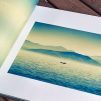
To make high-quality photographs, you need a set of conditions, including quality equipment, properly adjusted and clean optics, and, of course, a good film. The film is very important: experienced photographers say that even the best camera will not make a good picture if you choose the wrong film. But how to select the proper film? There are a lot of parameters to pay attention to, so in this article, I’ll try to review them one by one.
Film Format
In most cases, the film format is determined by your camera. The most popular models are cameras for narrow film type 135 (35 mm format). The cassette for this is a thin cylindrical cassette, and the film comes with a double-sided perforation. The standard capacity of such a film is 36 frames of small-format 24×36 mm. Also, a shortened film for 12 or 24 frames can be loaded into the cassette, which accordingly divides the product into subtypes: 135-36, 135-24, and 135-12. Such film types can be used in small-format, half-format, and panoramic cameras.
Film Color
If the camera determines the film format, the photographer can choose the film’s color, but beginners often wrongly think there are only two options: colored and black-and-white film. In fact, there are a few more, and the division is based on the development method.
Classic Color Negative Film

Color negative film is the most popular, so some people think it’s the only type of film on the market (it’s just sold everywhere and as affordable as possible). This type of color film is characterized by an orange-colored negative with inverted colors. The development process is defined by the code “C-41,” and occasionally, the film itself is also called like that.
There are two basic types of color negative film: for shooting in daylight and artificial light. The difference is determined by the balance of sensitivity of emulsion layers, so you can identify the suitable model by a typical characteristic – ISO, which we will talk about later.
The convenience of the color-negative film is that you can develop it almost anywhere. What’s more, you can process it yourself, just like black and white films. But home development requires additional equipment and some skills, while laboratories with these services are inexpensive.
Slide Reversal Film
Slide reversal film is used less frequently because it requires a photographer to develop specific skills through experience. It does not forgive exposure errors and requires development in specialized laboratories; its development process is labeled as “E-6”. There is no stage where you can correct the density or color balance of a negative developed incorrectly during slide printing.
Slide film also comes in monochrome, including black and white, and gives atmospheric “deep” images that sometimes go from pure gray to other tones, such as gray-blue. In some cases, you will need filters to work with slide film: blue is recommended if you plan to photograph using incandescent light, orange if you need to shoot in daylight.
A significant disadvantage of slides is that they are not durable: each display through a projector damages the film, and usually, the slides are designed for a total demonstration time of not more than an hour. Because of this, the photos are hard to look at, and they deteriorate quickly. In addition, during the development of slides, colors degrade, a little photographic latitude and shutter speed is a peculiarity of the reversible color development process. As a result, slides become an amateur’s creation: if a person just wants to shoot on film for scanning, it is better to use an ordinary color negative film.
Black and White Film
There are quite a few varieties of black and white film, and each has its characteristics. Most of them are negative – this is the most popular type of b/w film. By the way, almost all photographic masterpieces were made in b/w – for a long time, there were no other options. I will try to describe all the most popular ones briefly.
Panchromatic Film

The peculiarity of this type is that it is sensitive to the entire range of visible color and captures UV rays. The result is grayer photos and high color expression. At the same time, the sensitivity of the panchromatic film is low, so it gives good image tonality and slight graininess. You can find options with ISO from 25 to 3200, and I most recommend buying the product with the universal value – 400.
Orthochromatic Film
The orthochromatic film appeared before the panchromatic film. Its distinctive feature is that it captures blue and green colors well but is less sensitive to orange and barely displays red. However, it is not very convenient to shoot using it because of the high difference in shades: blue and green turn out very light, while red and orange go into black shades.
Isochromatic Film
The isochromatic film is an intermediate solution between orthochromatic and panchromatic film. It is sensitive to the violet-blue spectrum and is suitable for yellow and green hues and poor for red hues.
Chromogenic Film
The chromogenic film is designed to produce monochrome images. It has low sharpness, increased graininess, and can have contrast problems. Such film is suitable for those who want to get soft transitions of light in a photo.
Exposure Latitude
Exposure latitude is the range of exposures that the photographic material can reproduce. Insufficient exposure latitude causes some of the detail to be lost in the highlights and shadows. Simply put, exposure latitude refers to the ability to display a range of brightness without distortion. The higher the value, the more control the photographer has over the final image and the more realistic the photograph looks. The film with low exposure latitude is more likely to show graininess or “noise” at thresholds.
When it comes to film, exposure latitude is commonly measured in exposure steps. The exposure latitude of a typical color reversal film varies from 4 to 5 steps; a good negative film has 6-7 steps, expensive professional films can have 10-11 steps of latitude. The exposure latitude is indicated in aperture divisions, such as “plus 3, minus 2,” which means you can open the aperture by no more than three divisions and close by no less than two.
In analog photography, exposure latitude is limited by the film’s capabilities. An exception is if you develop the photos yourself, then you have the opportunity to influence the exposure latitude. It’s easier when working with black and white film: overexposed film can be underexposed, thereby increasing the latitude but decreasing the photo’s contrast. Conversely, if the frame is underexposed, overexposure is used, increasing the picture’s contrast.

Light Sensitivity
Sensitivity to light is the ability of photographic material to change under the influence of light. It is expressed by an ISO number, for example, 50 ISO, 100 ISO, 200 ISO, and so on; the higher the number, the greater the film’s sensitivity to the light. That means that depending on the sensitivity of the photographic material, the same amount of black in the developed picture can be achieved by different amounts of light striking the film. A black shadow on a sunny day can be the same tone as a black street at night if the appropriate film is chosen.
Each type of film behaves in a different way when shooting, so it is customary to match the sensitivity to a particular task. It is pretty challenging to do: there is no common standard or universal solution, but you can try to find a suitable option based on the general characteristics of films.
Light-sensitive films produce good pictures in low light conditions, they are not afraid of dark rooms and cloudy days, but the images taken on them are very grainy.
The low-sensitivity film doesn’t have grain, but it needs a high shutter speed (i.e., it won’t make fast action shots – they’ll be blurry). This film is suitable for daytime landscape photography and some portraits.
List of ISOs and Typical Applications
- 25 to 100 ISO – suitable for shooting at the beach, by the water, on a sunny day, on the ski slope;
- 200 ISO – recommended for outdoor use in good light. Suitable for shooting on the sports field, in the yard. Considered a universal solution for daylight photography;
- 400 ISO – a typical film for taking pictures in a well-lit room if it is not a studio but an ordinary apartment or office;
- 800 ISO – recommended for outdoor photography at dawn or dusk, when taking pictures of objects in shadow;
- 1600 ISO – suitable for fast-moving objects: runners, animals, gymnasts, racing cars.
Experienced photographers recommend using film with the lowest sensitivity but suitable for a particular situation. Beginners are advised to take a set of two reels: 200 ISO (24-36 shots) and 400 ISO (24-36 shots). If you want to shoot quicker, you can look for the 12-shot film, but they are often not enough – you have to refill the second one.





